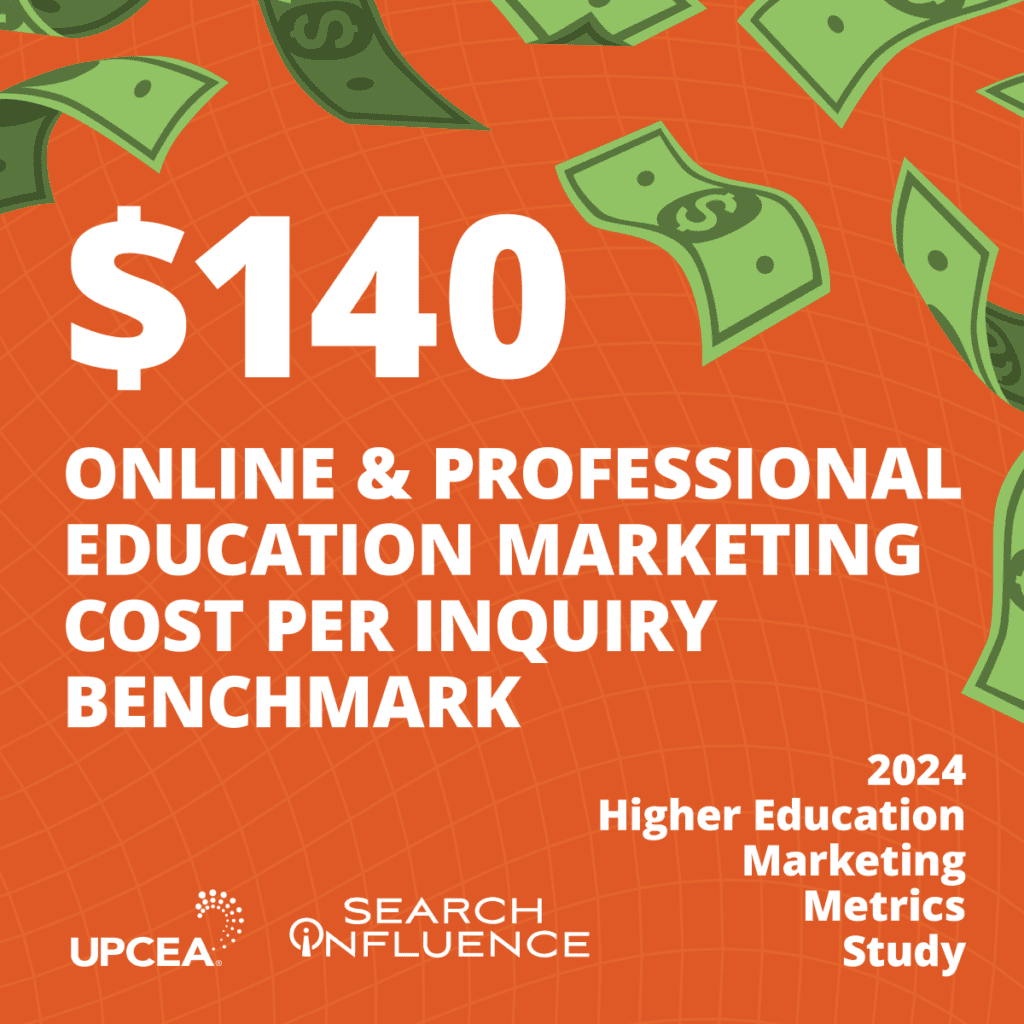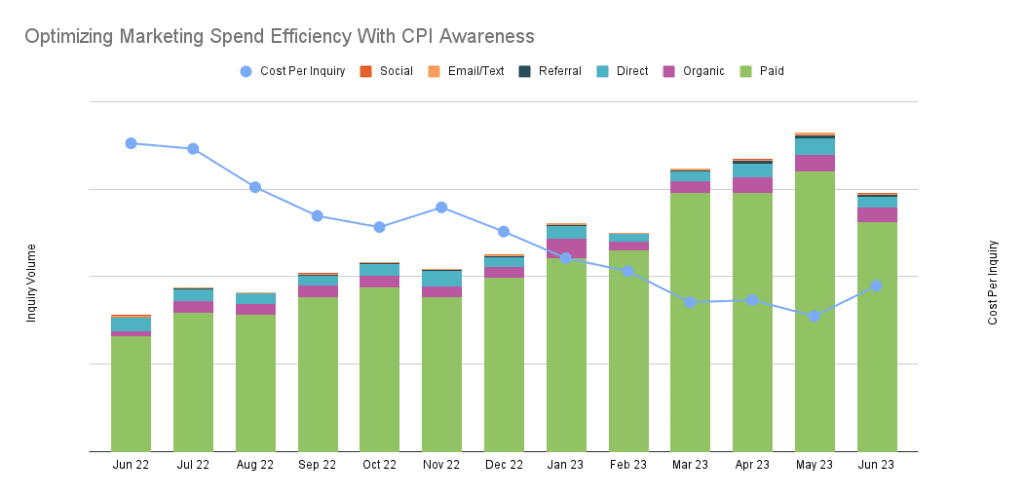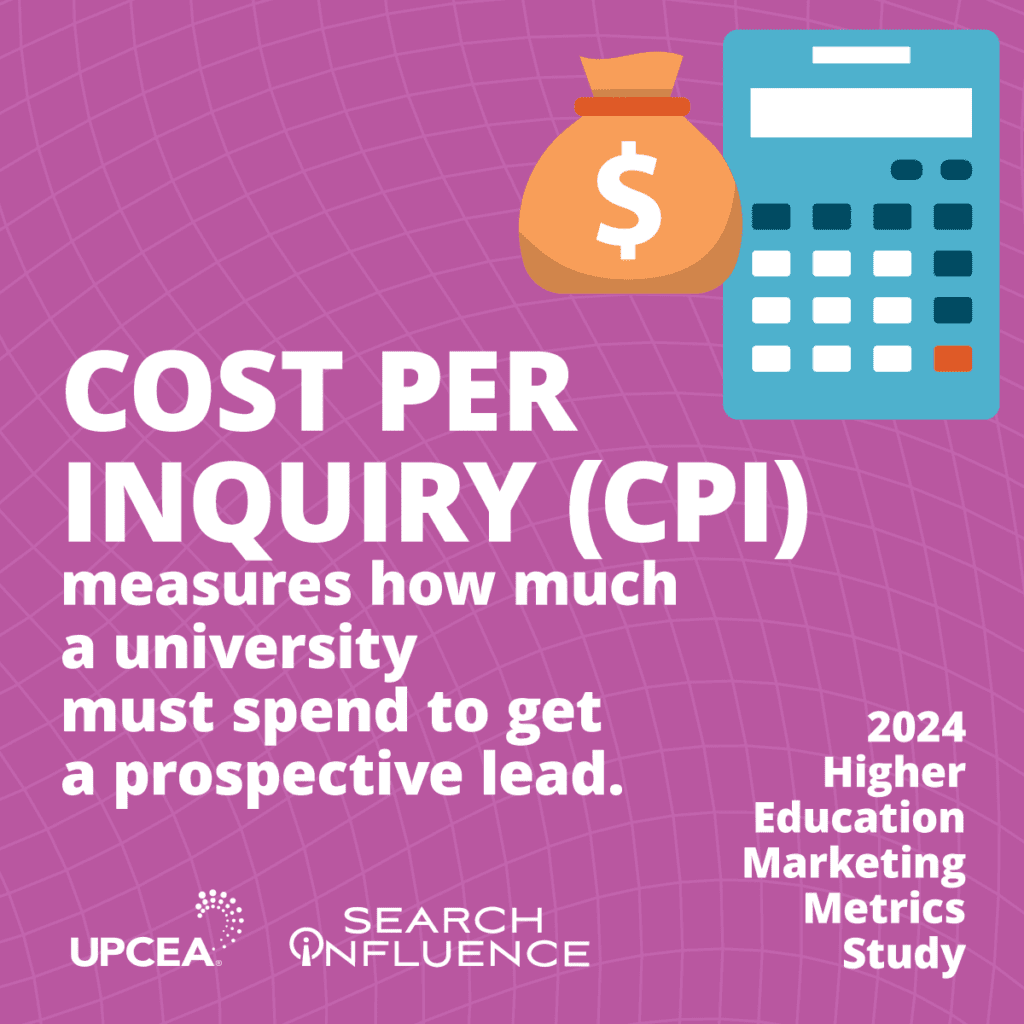Industry Insights
Valuable insights from UPCEA's trusted corporate partners.
Understanding Cost Per Inquiry in Higher Education Marketing
Summary
Cost per inquiry in higher education marketing is the ultimate metric of success. Ensure you’re measuring it accurately with UPCEA & Search Influence’s CPI benchmark.
Marketing cost per inquiry (CPI) is a primary signifier of how well your marketing is performing, but it has historically lacked a critical aspect that makes it a valuable barometer for success: its very own benchmark.
Search Influence and UPCEA have addressed this crucial gap in higher education marketing with our Marketing Metrics Research Report: What Gets Measured Gets Managed. This research report sets a nationwide benchmark for cost per inquiry for continuing and online education marketing. By establishing this benchmark, we aim to inspire more universities to understand and calculate their CPI and use cost metrics to effectively optimize their marketing strategy.
The data includes what your peers are paying per inquiry or lead for graduate, undergraduate, and non-credit programs.
Higher ed marketers looking to optimize your strategy and your results can compare their own CPI to the benchmarks to assess if they are delivering leads to the university at, above, or below the cost achieved by other universities. Ultimately, taking action based on trends in CPI can boost your university’s enrollment.
Understanding Cost Per Inquiry in Higher Education Marketing
CPI measures the financial investment to generate a single inquiry or lead. Measuring and analyzing CPI is a must for educational institutions to strategically allocate their marketing budget and improve their engagement with prospective college students.
For higher education marketing, CPI measures the costs associated with getting potential students to take that first step and engage with your institution – filling out an interest form, scheduling a tour, booking a meeting with an advisor, downloading a brochure, or even starting an application.
Typically, universities include media spend in their CPI calculation. 38% also include agency fees. 46% include all marketing expenses (excluding salaries).
The Importance of Measuring Cost Per Inquiry in Higher Education Marketing
Measuring CPI steers your digital marketing campaigns toward success. This metric empowers you to gauge your efficiency, optimize your budgets, and make data-driven decisions along the way.
By demonstrating the value of your lead expenditures, CPI helps you:
- Gain Confidence in Inquiry Generation: If you’re like 50% of marketers in 2023, lead generation is among your top goals. But how do you know you’re driving leads effectively? In measuring CPI, you gain confidence that your marketing efforts are attracting the right number of inquiries, in line with your goals.
- Benchmark Against Industry Standards: CPI enables you to benchmark your marketing results against industry standards, ensuring your strategies meet or surpass the average performance in your sector.
- See the Big-Picture Perspective: Understanding CPI provides a wide-ranging, thorough view of your marketing campaign’s success. This insight is crucial for recognizing when higher CPIs might be justified for specific programs or campaigns or for experimenting with innovative marketing approaches.
- Judge Realistic Vendor Promises: Utilizing CPI helps verify the accuracy and realism of claims made by external vendors, helping you to align their promises with achievable targets and industry benchmarks.
As the education sector continues to evolve, you need to understand and harness the power of CPI to stay competitive and achieve your institution’s marketing goals.
Search Influence and UPCEA’s CPI Benchmark
Since becoming an UPCEA Platinum Partner in 2022, Search Influence has worked with UPCEA to make higher education marketing success—from search engine optimization to paid advertising— more accessible.
Our latest collaboration established a credible, industry-specific benchmark for both cost per inquiry and cost per enrolled student.
Utilizing our CPI Benchmark Survey, we collected input and data from a range of higher education digital marketers on the metrics they use to track their success, cost per inquiry and cost per enrolled student by program type, what they include in their calculation, and satisfaction with their success and ability to track the success of their marketing.
Our research study showed that 92% of those who are satisfied with their ability to track also report satisfaction with the performance of their marketing campaigns. This reinforced the critical importance of industry benchmarks to improve higher education marketing performance.
According to the study, the benchmarks for key marketing cost metrics, cost per inquiry and cost per enrolled student, are:
$140: Cost Per Inquiry Benchmark
- $128: Undergraduate programs
- $157: Graduate programs
- $51: Non-credit programs
$2,849: Cost Per Student Benchmark
- $1,505: Undergraduate programs
- $3,804: Graduate programs
- $599: Non-credit programs

From media spend to agency fees, multiple key players factor into CPI — and not all apply to every university. We hope that, armed with an industry-standard benchmark, more universities will measure their own CPI and be more cognizant of what’s included.
Not sure what your institution’s CPI looks like? Our beginner-friendly CPI Worksheet was designed for marketers looking to make the most use of your budget. Fill out the worksheet to see how you can calculate with confidence and compare it to a wider industry standard.
A CPI Optimization Success Story With Tulane University

Search Influence’s work with the Tulane School of Professional Advancement (SoPA) presents a compelling case study in CPI optimization.
For over five years, our team closely tracked the university’s monthly CPI. Over the 2022-2023 fiscal year, we emphasized optimizing their costs downward. This initiative, grounded in strategic decision-making and precise execution, yielded extraordinary results — surpassing any initial expectations set at the start of this ambitious goal.
After just one year, we witnessed nearly double the inquiries while marketing with a budget similar to previous years.
Although we lacked a trusted CPI benchmark, our focus on CPI and its optimization enabled us to lower it by nearly half in a year, which resulted in 2x as many inquiries for a very similar marketing spend.
Together with Tulane SoPA, we keep a pulse on this data monthly, giving us confidence and understanding as the numbers fluctuate. It also serves as a jumping-off point to look at deeper metrics, like lead quality and conversion ratios, as the prospective student moves through the enrollment funnel.
What can your institution make possible with the power of CPI calculations?
Learn More About CPI Benchmarks in Higher Education Marketing
Effectively measuring CPI isn’t a guessing game, and neither is establishing a nationwide benchmark for it. Together with UPCEA, we used the power of real-world data to create the first-ever industry standard, one that will revolutionize the way we look at higher ed marketing success.
Need more information about calculating your institution’s cost per inquiry and cost per enrolled student?
Utilize our CPI Worksheet to optimize your higher education marketing campaigns with data-driven decisions.
And gain even more in-depth insights into your marketing metrics and their associated costs with our Marketing Metrics Research Report: What Gets Measured Gets Managed.
Paula French is a Director at Search Influence, a leading digital marketing agency specializing in higher education. With over 15 years of experience crafting and leading digital marketing campaigns for major organizations, Paula has a proven track record of helping institutions like Tulane School of Professional Advancement effectively reach and engage their target audiences.

